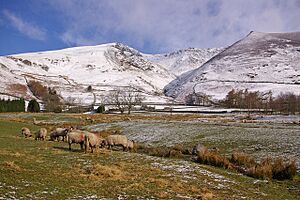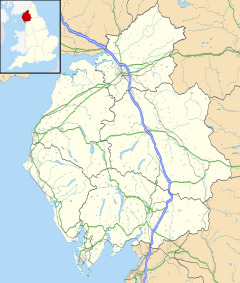Threlkeld facts for kids
Quick facts for kids Threlkeld |
|
|---|---|
| Village and parish | |
 Blease Gill |
|
| Population | 423 (2011) |
| OS grid reference | NY3125 |
| Civil parish |
|
| Unitary authority |
|
| Ceremonial county | |
| Region | |
| Country | England |
| Sovereign state | United Kingdom |
| Post town | KESWICK |
| Postcode district | CA12 |
| Dialling code | 017687 |
| Police | Cumbria |
| Fire | Cumbria |
| Ambulance | North West |
| EU Parliament | North West England |
| UK Parliament |
|
Threlkeld is a small village in the northern part of the Lake District in Cumbria, England. It is located east of Keswick. The village sits at the bottom of Blencathra, a famous mountain in the northern Lake District. The River Glenderamackin flows north of the village. In 2011, about 423 people lived in Threlkeld.
Contents
What's in the Name Threlkeld?
The name Threlkeld comes from old Norse words. Thraell meant a slave or servant, and kelda meant a spring or well. This name likely came from the time when Vikings settled in the area, between the 790s and 1066. The word thraell might have referred to the native Cumbrian people who lived there before the Norse arrived.
Village History and Transport
Threlkeld was once part of a historical area called Cumberland. The village used to have its own train station. This station was part of the Cockermouth, Keswick and Penrith Railway. It was located across the valley, near the old Threlkeld Quarry. Today, the old railway line is a path for walking and cycling.
Near the old station, you can see three rows of houses. These houses were built for the people who worked at the quarry. The Threlkeld Quarry and Mining Museum is now open nearby. Visitors can ride a special 2 ft (610 mm) narrow gauge train there.
Life in Threlkeld Today
Threlkeld has a few places where people can gather. There are two pubs, The Salutation and the Horse and Farrier, which are across from each other. The village also has a coffee shop and a lively Village Hall. A small church, called St Mary's, is also in the village.
A Special Hospital
From 1904 to 1958, High Row in Threlkeld was home to the Blencathra Isolation Hospital. This was one of the first special hospitals in England called a Sanatorium. It was built to help people who had tuberculosis, a serious lung disease. The hospital closed because fewer people were getting tuberculosis. From 1958 to 1972, the building was used as a long-term home for older people.


